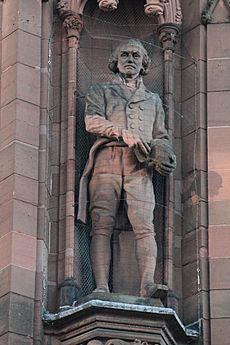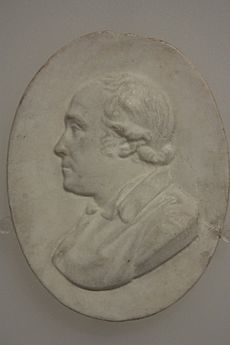John Hunter (surgeon) facts for kids
Quick facts for kids
John Hunter
|
|
|---|---|

Painted by John Jackson, 1813, after Sir Joshua Reynolds, 1786
|
|
| Born | 13 February 1728 Long Calderwood near East Kilbride, Scotland
|
| Died | 16 October 1793 (aged 65) London, England
|
| Nationality | Scottish |
| Education | St Bartholomew's Hospital |
| Known for | Scientific method in medicine Many discoveries in surgery and medicine |
| Medical career | |
| Profession | Surgeon |
| Institutions | St George's Hospital |
| Research | Dentistry, gunshot wounds, ... diseases, digestion, child development, foetal development, lymphatic system |
| Awards | Copley Medal (1787) |
John Hunter FRS (13 February 1728 – 16 October 1793) was a Scottish surgeon, one of the most distinguished scientists and surgeons of his day. He was an early advocate of careful observation and scientific method in medicine. He was a teacher of, and collaborator with, Edward Jenner, pioneer of the smallpox vaccine. He paid for the stolen body of Charles Byrne, and proceeded to study and exhibit it against the deceased's explicit wishes. His wife, Anne Hunter (née Home), was a poet, some of whose poems were set to music by Joseph Haydn.
He learned anatomy by assisting his elder brother William with dissections in William's anatomy school in Central London, starting in 1748, and quickly became an expert in anatomy. He spent some years as an Army surgeon, worked with the dentist James Spence conducting tooth transplants, and in 1764 set up his own anatomy school in London. He built up a collection of living animals whose skeletons and other organs he prepared as anatomical specimens, eventually amassing nearly 14,000 preparations demonstrating the anatomy of humans and other vertebrates, including 3,000+ animals.
Hunter became a Fellow of the Royal Society in 1767. He was elected to the American Philosophical Society in 1787. The Hunterian Society of London was named in his honour, and the Hunterian Museum at the Royal College of Surgeons preserves his name and his collection of anatomical specimens. It still contains the illegally procured body of Charles Byrne, despite ongoing protests.
Contents
Early life
Hunter was born at Long Calderwood to Agnes Paul (c.1685–1751) and John Hunter (1662/3–1741), the youngest of their ten children. Three of Hunter's siblings (one of whom had also been named John) died of illness before he was born. An elder brother was William Hunter, the anatomist. As a youth, he showed little talent, and helped his brother-in-law as a cabinet-maker.
Education and training
When nearly 21 years old, he visited William in London, where his brother had become an admired teacher of anatomy. Hunter started as his assistant in dissections (1748), and was soon running the practical classes on his own. It has recently been alleged that Hunter's brother William, and his brother's former tutor William Smellie, were responsible for the deaths of many women whose corpses were used for their studies on pregnancy. Hunter is alleged to have been connected to these deaths, since at the time he was acting as his brother's assistant.
However, persons who have studied life in Georgian London agree that the number of pregnant women who died in London during the years of Hunter's and Smellie's work was not particularly high for that locality and time; the prevalence of pre-eclampsia — a common condition affecting 10% of all pregnancies, and one which is easily treated today, but for which no treatment was known in Hunter's time — would more than suffice to explain a mortality rate that seems suspiciously high to 21st-century readers. In The Anatomy of the Gravid Uterus Exhibited in Figures, published in 1774, Hunter provides case histories for at least four of the subjects illustrated.
Hunter heavily researched blood while bloodletting patients with various diseases. This helped him develop his theory that inflammation was a bodily response to disease, and was not itself pathological.
Hunter studied under William Cheselden at Chelsea Hospital and Percival Pott at St Bartholomew's Hospital. Hunter also studied with Marie Marguerite Bihéron, a famous anatomist and wax modeler teaching in London; some of the illustrations in his text were likely hers. After qualifying, he worked at St George's Hospital as assistant surgeon from 1756, then as surgeon from 1768.
Hunter was commissioned as an Army surgeon in 1760 and was staff surgeon on expedition to the French island of Belle Île in 1761, then served in 1762 with the British Army.
Post-Army career
Hunter left the Army in 1763, and spent at least five years working in partnership with James Spence, a well-known London dentist.
Hunter set up his own anatomy school in London in 1764 and started in private surgical practice.
Self-experimentation
Hunter was elected as Fellow of the Royal Society in 1767.
.....
Late career
In 1768, Hunter was appointed as surgeon to St George's Hospital. Later, he became a member of the Company of Surgeons. In 1776, he was appointed surgeon to King George III.
In 1783, Hunter moved to a large house in Leicester Square. The space allowed him to arrange his collection of nearly 14,000 preparations of over 500 species of plants and animals into a teaching museum. The same year, he acquired the skeleton of the 2.31 m (7' 7") Irish giant Charles Byrne against Byrne's clear deathbed wishes—he had asked to be buried at sea.
Hunter bribed a member of the funeral party (possibly for £500) and filled the coffin with rocks at an overnight stop, then subsequently published a scientific description of the anatomy and skeleton. "He is now, after having being stolen on the way to his funeral," says legal scholar Thomas Muinzer of the University of Stirling, "on display permanently as a sort of freak exhibit in the memorial museum to the person who screwed him over, effectively." The skeleton, today, with much of Hunter's surviving collection, is in the Hunterian Museum at the Royal College of Surgeons in London.
In 1786, he was appointed deputy surgeon to the British Army and in March 1790, he was made surgeon general by the then Prime Minister, William Pitt. While in this post, he instituted a reform of the system for appointment and promotion of army surgeons based on experience and merit, rather than the patronage-based system that had been in place.
Hunter's death in 1793 was due to a heart attack brought on by an argument at St George's Hospital concerning the admission of students. He was originally buried at St Martin-in-the-Fields, but in 1859 was reburied in the north aisle of the nave in Westminster Abbey, reflecting his importance to the country.
He was described by one of his assistants late in his life as a man 'warm and impatient, readily provoked, and when irritated, not easily soothed'.
Family
In 1771, he married Anne Home, daughter of Robert Boyne Home and sister of Sir Everard Home. They had four children, two of whom died before the age of five. One of his infant children is buried in the churchyard in Kirkheaton, Northumberland, and the gravestone is Grade II listed. Their fourth child, Agnes, married General Sir James Campbell of Inverneill.
Legacy
In 1799, the government purchased Hunter's collection of papers and specimens, which it presented to the Company of Surgeons.
Contributions to medicine
..... He carried out the first recorded artificial insemination in 1790 on a linen draper's wife.
Memorials
The John Hunter Clinic of the Chelsea and Westminster Hospital in London is named after him, as are the John Hunter Hospital in Newcastle, Australia and the Hunterian Neurosurgical Laboratory of the Johns Hopkins Hospital.
His birthplace in Long Calderwood, Scotland, has been preserved as Hunter House Museum.
There had been a bust of Hunter in Leicester Square until the 2010–12 redesign of the square.
See also
 In Spanish: John Hunter para niños
In Spanish: John Hunter para niños



